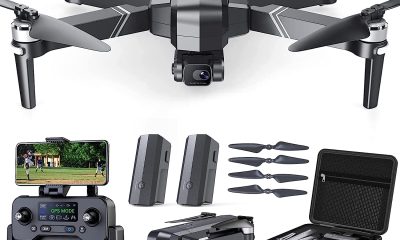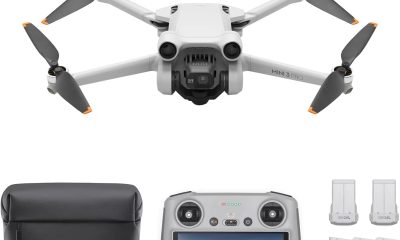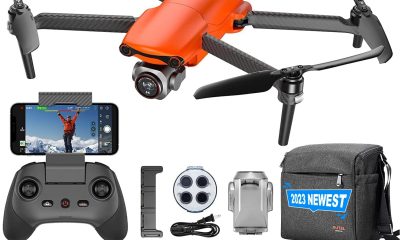Home
Smart Gardening in Your Home: Indoor/Outdoor Plant Care Technology Solutions

The technology has crossed over from light control, security systems, thermostats, and other smart home areas to gardening because it succeeded in inventing ingenious ways of monitoring, nurturing, and optimizing plants inside and outside. Smart gardening tools promise a leap in convenience and efficiency for the tech-savvy gardener: think plants getting exactly what they want, in style, with much less hassle. So, let’s dive in and see exactly how technology can revolutionize your gardening experience.
1. Computer-controlled Irrigation Systems
One of the major problems that many people have with gardening is how much water to give. Smart irrigation systems take all the guesswork out; they can do this automatically to provide water in volumes needed by your garden. Employing sensors that measure current soil moisture levels, current weather, and even the type of plant, it will automatically engage the irrigation system once the soil gets to a dry enough state to water your plants.
Others even extend their functionality to home assistants, including Google Home and Amazon Alexa, like Rachio or RainMachine. Further, they come with mobile apps for remote monitoring and adjustment of a watering schedule. Systems like these will also save water and cut time since only the right amount is delivered, in fact, for the plants to be kept healthy.
2. Smart Plant Sensors
Smart plant sensors can be a game changer for those who love indoor plants but can’t quite seem to keep them thriving. The Xiaomi Mi Flora and Parrot Flower Power are just two devices that will monitor soil moisture, light levels, temperature, and fertilizer content—all very critical to the survival of plants. These sensors gather information in real time and send data to an app that will give recommendations to help your plants thrive.
You will be immediately informed if the flora does not get enough light or water.
Most smart plant sensors are relatively easy to set up and can enforce a complete guide to plant care with their respective applications. Be it herbs, interior plants, or highly sensitive flowers, these sensors will help make out what your plants need.
3. Smart Indoor Gardens
For apartment dwellers and those with minor back or front yards, an indoor smart garden provides the convenience of growing a great deal of greens, vegetables, and sometimes flowers throughout the year. AeroGarden and Click and Grow have been capable of incorporating LED grow lights, automatic waterings, and nutrient-dispensing systems into their designs. This cover setup makes growing plants very easy with no concern whatsoever about weather or season.
These indoor gardens are smart enough to guarantee enormous success for anyone when it comes to growing plants—both those who have experience and those who do not. Plant the seeds or pods, set up the mechanism, and let the smart technology take over. Other models will offer accompanying applications which may advise a little at different stages of plant growth, and will signal when the time comes to add water and/or nutrients.
4. Robotic Lawn Cutters
Having a well-maintained lawn is seriously time-consuming, while the Husqvarna Automower will be doing this in your place. These fully autonomous machines, apart from doing the cuttings themselves, require no human intervention. Equipped with sensors that detect obstacles, they will keep your yard impeccable by their own means. Schedule the lawn mowing using an app to have the grass cut regularly and uniformly.
Several robotic mowers are also fitted with weather sensors, which change the pattern of mowing, depending on the growth of the grass or according to weather conditions in order not to damage your lawn on rainy days. Others integrate into smart house systems—meaning one could control them with their voice.
5. Intelligent Greenhouse Technology
Serious gardeners have used greenhouses, but smart greenhouse technology takes that to another dimension. Systems like Growlink and FarmBot allow the gardener to computerize controls for such variables as temperature, humidity, and lighting—all factors in optimum plant growth. Most of those smart systems are already using AI and machine learning these days for the prediction of changes in the environment and self-adjusting, thus helping plants grow in their controlled environment.
Smart gardening solutions are about to change the way people take care of their plants. Equipped with a new automated watering system, smart plant sensor, indoor garden, robotic lawn mower, and smart greenhouse, maintaining a rich, green garden was never easier. Be it an avid or a new gardener, smart insertion into your routine saves you time, cuts down the amount of work involved, and helps in getting the best from your plants throughout the year. Welcome to the future of gardening: a simple tap on a screen of your cellular phone.
Home
Smart Speakers and Voice Assistants: The Complete Guide

In this fast-changing world of smart home technology, there’s nothing indelicate about using these devices to make life more encouraging. These cleverly invented devices revolutionize the way we interact with technology; let’s not leave out the many means of communication one has come up with: hands-free control, instant information, and integration with other smart home gadgets. Whether you’re just dipping into the cool waters of this new world or upgrading, this guide will take you through navigating smart speakers and voice assistants.
What Are Smart Speakers?
This next group includes wireless speakers that have Voice Assistants, which work on commands to receive instructions and do everything from playing music to setting reminders, commanding smart home devices, and answering questions. These speakers come in different shapes and sizes, starting with a compact and cheap bunch to the high-line models boasting better sound quality.
Well-known Voice Assistant
Some of the most popular voice assistants that are used to power smart speakers include Alexa from Amazon, Google Assistant, and Apple’s Siri. All of these with different features and integrations.
Alexa, the voice assistant behind Amazon Echo can do everything from ordering groceries to controlling smart home devices by adding a long list of “skills.” One of the major strong points of Alexa is its compatibility with third-party devices.
The assistant in-built into the Google Nest speaker seems to ace at two aspects: accuracy of information and full integration with the Google ecosystem, such as Google Calendar, Gmail, and Google Maps. Particularly, it does really well with question answering and task execution.
Siri: Apple has integrated Siri into the HomePod and HomePod mini. Because Siri is so thoroughly integrated into the system, this service works wonders for those who are essentially reliant on their Apple devices. This is almost a frictionless user experience from an Apple user’s point of view, although much more third-party compatibility is presented with Alexa and Google Assistant.
Key Features and Benefits
Smart speakers offer numerous features that make them invaluable in modern households:
Hands-Free Convenience: You can command almost anything in your home as voice assistants do the job. These have enabled easy activities, including adjusting the thermostat, switching off lights, and setting up timers.
Smart Audio for Any Occasion: Smart speakers can stream music, podcasts, audiobooks, and more. Some smart speaker models further support multi-room audio, letting you synchronize your music across multiple rooms.
Smart Home Integration: Most of the smart speakers become the center to operate other smart home devices. Everything is voice-controlled; from smart lights to security cameras.
Personal Assistant: Need to set a reminder, make a shopping list, or check the weather? It’s a voice assistant that will now keep you organized and informed.
How to Choose a Smart Speaker
Just keep in mind the sound quality, compatibility with the ecosystem, and what exactly you want to do with it when considering the choice of a smart speaker. This applies especially to high-priced units, such as Apple HomePod or even the Sonos One, in case audio quality means the most to you. All in all, Alexa and Google Assistant-powered devices will provide the most flexibility for smart home enthusiasts.
Security and Privacy Considerations
There’s obviously the concern about everything connecting to the internet, and a big one, too: privacy and security. Because voice assistants are always ‘listening’ for the cue word, there is data collection involved. Learning how to mute the microphone or adjust the settings and controls will help users in terms of privacy.
Not just gadgets but tools that will revolutionize your life, making daily tasks way easier with your home being even smarter. In brief, authentic comprehension about it—in terms of its feature and capability—will place you in a better position to make an informed decision that will elevate your lifestyle. Be you a power user or an average Joe, there’s a smart speaker out there that will meet your needs.
Home
Top Kitchen Tools for an Upgraded Home

In today’s moving world, smart technology has greatly impacted aspects of our daily lives, including the kitchen. From appliances to gadgets, incorporating these devices can enhance your cooking routine, making it more efficient, enjoyable, and slightly futuristic. Let’s explore some kitchen tools that can contribute to an intelligent and connected household.
1. Intelligent Fridges
At the core of a kitchen lies the fridge. These appliances go beyond keeping your food chilled; they boast touch screens, built-in cameras, and online connectivity. Some models can even monitor your food’s freshness and recommend recipes based on your ingredients. Functions like voice activation, temperature control, and digital shopping lists make these fridges essential for homes.
2. Voice Controlled Helpers
Voice-controlled assistants like Amazon Echo or Google Home have become must-haves in kitchens today. They can set timers, suggest recipe ideas, convert units of measurement, and even oversee devices through voice prompts. Picture preparing a meal while your assistant manages timing and provides you with step-by-step guidance. These modern kitchen gadgets help simplify cooking tasks, making them more efficient and requiring less effort.
3. Innovative Ovens and Stovetops
Advanced ovens and stovetops allow for temperature adjustments and can be controlled remotely using your smartphone. This means you can preheat your oven while on the way or modify cooking settings without being physically present. Some models even feature built-in cameras to keep an eye on your food’s progress, preventing overcooking or burning.
4. Smart Coffee Machines
For coffee enthusiasts, a smart coffee maker can revolutionize their routine. These devices enable you to schedule brewing times, customize coffee strength, and manage the machine from your smartphone. Whether you prefer a brewed cup when you wake up or need to brew a pot in advance, these coffee makers bring convenience to your daily life.
5. Intelligent Kitchen Scales
Accuracy is crucial in cooking, and kitchen scales deliver that. These scales sync with your smartphone to provide detailed recipe recommendations and help with portion sizes. Some models connect with apps that assist in tracking intake and promoting healthy eating habits. With a scale, achieving recipes becomes effortless every time.
6. Connected Kitchen Appliances
The rise of multicookers and pressure cookers, such as the Instant Pot, has captured the attention of many. These innovative kitchen gadgets can be controlled remotely, offer various cooking modes, and often include pre-set recipes. They streamline cooking procedures and enable efficient multitasking.
7. Intelligent Dishwashers
Modern dishwashers not only excel at cleaning dishes but also boast advanced functionalities like remote operation and cycle monitoring. You can halt a wash cycle from your smartphone, track water consumption, and receive notifications upon cycle completion. Some models even feature sensors to optimize water and detergent usage for a more efficient approach.
8. Air Fryers with Wi-Fi Connectivity
The culinary world has embraced air fryers for their ability to create crispy dishes using minimal oil. Models with Wi-Fi capabilities take convenience up a notch by allowing you to adjust cooking settings, receive alerts, and access recipes via an application. This enables you to whip up meals with just a few taps on your phone.
9. Smart Toaster Innovations
The classic toaster has undergone a transformation into a device offering customizable browning preferences, presets for different bread types, and the option to manage it remotely through an app. Using a smart toaster allows you to achieve perfect toast every time, and some versions even have the capability to toast bagels and English muffins precisely.
10. High-Tech Sous Vide Devices
Sous vide cooking entails sealing food in a vacuum and cooking it in a water bath at a precise temperature. Advanced sous vide devices offer functions such as app connectivity, precise temperature regulation, and cooking timers. They guarantee that your dishes are cooked uniformly and reach the desired level of doneness, enhancing your culinary skills.
Adopting kitchen gadgets can greatly improve your cooking journey, making it more efficient and delightful. From voice-controlled helpers to advanced appliances, these tools not only simplify cooking chores but also seamlessly blend into your smart home ecosystem. By integrating these tools into your kitchen, you can leverage state-of-the-art technology to streamline meal prep, enhance productivity, and infuse a touch of convenience into your daily routine.
Home
Smart Lighting; Fresh Concepts, for Todays Homes

In the evolving world of home technology, smart lighting stands out as a transformative upgrade for modern living spaces. This advanced system not only enhances the appeal of your home but also significantly improves energy efficiency and convenience. Let’s explore how smart lighting setups can illuminate your home in new and exciting ways.
Exploring Smart Lighting
Smart lighting systems allow for remote management through smartphones, tablets, or voice commands. These systems integrate seamlessly with home automation platforms, offering features that go beyond simple on/off controls. From adjusting brightness and hues to scheduling tasks and creating various moods, smart lighting provides a level of control and personalization that traditional lighting options simply cannot match.
Key Aspects of Smart Lighting
Remote Management and Automation: One of the standout features of smart lighting is the ability to control your lights from anywhere. Whether you’re at home or away on a trip, you can tweak lighting settings via an app. Additionally, smart lights can be programmed to switch on or off at specific times, simulating your presence or syncing with your daily routines.
Voice Command Capability: Integration with voice-activated assistants such as Amazon Alexa, Google Assistant, or Apple’s Siri offers hands-free operational convenience. You can adjust lighting by dimming, changing colors, or turning it on and off using voice commands, making daily tasks more manageable.
Customizing Colors and Brightness: Many smart lighting systems offer a range of color temperatures and RGB features, allowing you to create the perfect ambiance for any occasion. Whether you prefer a cozy glow for a relaxing evening or vibrant colors for a celebration, smart lighting lets you tailor the color and brightness to suit your needs.
Energy Efficiency: Smart lighting solutions often use LED technology, which is more energy-efficient than traditional incandescent bulbs. Additionally, smart lights can be programmed to turn off when not in use, reducing energy consumption and lowering electricity costs.
Integration with Smart Devices: Smart lighting can connect with other smart home gadgets, such as motion sensors, security cameras, and thermostats. For example, lights can be set to turn on when motion is detected or adjust based on natural light availability and the time of day.
Advantages of Smart Lighting
Improved Convenience: Managing your lighting through an app or voice commands offers unparalleled convenience. No more fumbling for switches in the dark or worrying about whether you’ve left the lights on when you head out.
Enhanced Security: Smart lighting can boost home security by mimicking your activity while you’re away. You can schedule lights to turn on and off at specific times, deterring potential intruders. Additionally, linking lights with motion sensors and security cameras can alert you to any unusual activity.
Personalized Touch: With smart lighting, you can create lighting scenes tailored to your activities or moods. Whether you’re setting up for a movie night, preparing for dinner, or working late, you can adjust the lighting to perfectly match your needs.
Well-being: Proper lighting can significantly impact your well-being and productivity. Smart lighting can help regulate your body’s circadian rhythm by mimicking daylight patterns, which can enhance sleep quality and overall health. For instance, evening lights can promote relaxation, while cooler, brighter lights during the day can boost alertness and focus.
Selecting the Ideal Smart Lighting Setup
When choosing a smart lighting system, consider the following factors:
Compatibility: Ensure that the smart lighting system you choose is compatible with your existing home automation platform or voice assistant. Some systems work better with specific platforms, so it’s essential to verify compatibility.
Setting Up: Installation ease varies among smart lighting systems. Some can be fitted into existing fixtures with minimal effort, while others may require more complex configurations. Choose a system that matches your comfort level and installation skills.
Budget Consideration: Smart lighting systems come in a range of price points, from budget-friendly options to high-end models with extensive features. Determine your budget and select a system that offers the desired features without exceeding your financial limits.
Brand and User Feedback: Research different brands and read user reviews to gauge the reliability and performance of various smart lighting options. Opt for brands with positive reviews and a reputation for excellent customer service.
Smart lighting offers a modern solution for homes, providing unmatched convenience, customization, and efficiency. By integrating smart lighting into your living space, you can enhance your home’s ambiance, improve energy management, and enjoy personalized lighting tailored to your preferences. Whether you’re tech-savvy or simply looking to elevate your home environment, smart lighting is a game-changer that can revolutionize how you illuminate your surroundings. Embrace the future of lighting technology and discover how smart solutions can brighten your life.
Trending

 Drones1 year ago
Drones1 year agoRuko-F11GIM-Drones-Camera-Batteries

 Drones1 year ago
Drones1 year agoDJI’s tiny drone

 Home1 year ago
Home1 year agoElectroSave Review

 Drones1 year ago
Drones1 year agoAutel Robotics EVO Lite+ Review

 Bug Repellant Gadgets1 year ago
Bug Repellant Gadgets1 year agoSmosquito Review

 Photography & Videography Drones1 year ago
Photography & Videography Drones1 year agoStealth Hawk Pro Drone Review

 Beauty Gadgets1 year ago
Beauty Gadgets1 year agoBright Selfie Review

 Drones1 year ago
Drones1 year agoSwellpro-Fisherman-Fishing-Waterproof-Propellers Review





















